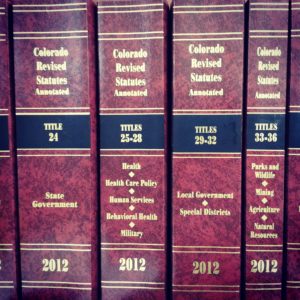Editor’s Note: This is the fifth in a series of seven articles on statutory construction that LegiSource is reposting during the 2019 legislative interim. This article was originally posted July 30, 2015. We will post the sixth article in two weeks.
by Julie Pelegrin
As has been discussed in previous articles, when a court must apply a statute to the facts and decide what the statute means, it will first look to the plain language of the statute. Assuming the statute is clear and unambiguous, the court will not use any other tools or rules to interpret the statute; if the language is plain, then the statute means what it says.
But, if the language is not plain and the statute could be read to have more than one meaning or application, then the court will look to the General Assembly’s intent in enacting the statute.
In part 2 of article 4 of title 2, C.R.S., the General Assembly enacted several guides to help the courts – and individuals and state agencies – read the statutes and determine what the General Assembly intended to allow or prohibit. This week’s article looks at legislative intent, including the general intent that statutes apply to future actions and events.
General intentions in enacting statutes: §2-4-201, C.R.S.
Under section 2-4-201, C.R.S., every statute is based on five underlying presumptions:
- The statute is intended to be constitutional with regard to both the United States and Colorado constitutions;
- Every part of the statute is intended to be effective – no superfluous words or sections;
- When implemented, the statute is intended to have a just and reasonable result;
- The statute is intended to be feasible – i.e., someone is supposed to be able to implement the statute; and
- If implementing the statute one way will benefit the public interest and implementing it another way will benefit a private interest, the General Assembly intends to benefit the public interest.
In applying these presumptions, the courts have taken some of them one or two steps further. A court not only presumes that a statute is constitutional, if a person claims that a statute is not constitutional, the court requires that person to prove the statute’s unconstitutionality beyond a reasonable doubt. And, if a court can read a statute two ways – a constitutional way and an unconstitutional way – it must choose the constitutional reading.
Every word in every statute is supposed to have meaning and be effective. To apply this presumption, the courts read the parts of each statutory section, part, and article as a whole and interpret the various portions consistently with one another. If it appears that portions of a statute conflict, the court will try to harmonize those portions and, as much as possible, give a consistent and sensible effect to every portion.
The courts have added a presumption of their own with regard to the words in statutes. The court presumes that, when it amends or creates a statute, the General Assembly acts with deliberation and full knowledge of any previous case law interpreting or defining the words used in that area of the statutes. If the General Assembly uses the same words that the court has previously interpreted in a related area of statute, and does not clarify that it intends to change the interpretation of the words, the General Assembly is presumed to agree with the court’s earlier interpretation. If the General Assembly amends a statute that a court has previously interpreted, the court assumes that the General Assembly agrees with the court’s interpretation of any portion of the statute that it does not amend.
The statutes are intended to have a “just and reasonable result” and are intended to be implemented. So, a court will interpret a statute according to the General Assembly’s intent, rather than according to a literal interpretation of the words, if the literal interpretation would defeat the General Assembly’s intent or lead to an absurd result. And a court will not interpret a statute in a way that requires an impossible task.
Obviously, these presumptions sometimes conflict with one another. In that case, the court decides how to balance the competing presumptions in the best way possible to meet the General Assembly’s intent in passing the statute.
Statutes are Presumed to be Prospective: §2-4-202, C.R.S.
Section 2-4-202, C.R.S., is short and relatively clear: “A statute is presumed to be prospective in its operation.” So, unless the General Assembly specifically says differently, each new statute and amendments to existing statutes apply only to the actions and events that occur on or after the date that the statute takes effect. See “When Does an Act Become a Law? It depends.” for an explanation of when an act takes effect.
But the General Assembly in certain cases will specify that an act take effect on a date that is earlier than the date on which the act passes or that the act applies to actions or events that occur before, on, or after the effective date of the act. See “Ex Post Facto Laws, Effective Dates, and Legislative Time Travel” for an explanation of the constitutionality of retroactive laws.





